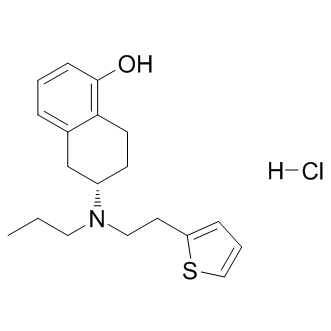
Rotigotine hydrochloride
CAS No. 125572-93-2
Rotigotine hydrochloride( Rotigotine HCl )
Catalog No. M11042 CAS No. 125572-93-2
A non-selective agonist of the dopamine D3 receptor (Ki=0.71 nM); has 10-fold selectivity for the D3 receptor over the D2, D4, and D5 receptors and 100-fold selectivity for the D3 receptor over the D1 receptor.
Purity : >98% (HPLC)
 COA
COA
 Datasheet
Datasheet
 HNMR
HNMR
 HPLC
HPLC
 MSDS
MSDS
 Handing Instructions
Handing Instructions
| Size | Price / USD | Stock | Quantity |
| 5MG | 41 | In Stock |


|
| 10MG | 59 | In Stock |


|
| 25MG | 88 | In Stock |


|
| 50MG | 126 | In Stock |


|
| 100MG | 176 | In Stock |


|
| 200MG | Get Quote | In Stock |


|
| 500MG | Get Quote | In Stock |


|
| 1G | Get Quote | In Stock |


|
Biological Information
-
Product NameRotigotine hydrochloride
-
NoteResearch use only, not for human use.
-
Brief DescriptionA non-selective agonist of the dopamine D3 receptor (Ki=0.71 nM); has 10-fold selectivity for the D3 receptor over the D2, D4, and D5 receptors and 100-fold selectivity for the D3 receptor over the D1 receptor.
-
DescriptionA non-selective agonist of the dopamine D3 receptor (Ki=0.71 nM); has 10-fold selectivity for the D3 receptor over the D2, D4, and D5 receptors and 100-fold selectivity for the D3 receptor over the D1 receptor; behaves as a full agonist of D1, D2, and D3 with similar potencies (EC50) in functional assay; also demonstrates significant affinity at α-adrenergic (α2B, Ki=27 nM) and serotonin receptors (5-HT1A Ki=30 nM); significantly attenuates MPTP-induced acute cell degeneration in mouse model.Parkinson's Disease Approved(In Vitro):Rotigotine (N-0923) has a 10-fold selectivity for D3 (pKi 9.2) receptors compared with D2, D4 and D5 (pKi 8.5-8.0) and a 100-fold selectivity compared with D1 receptors (pKi 7.2). In functional studies, Rotigotine (N-0923) behaves as full agonist at all dopamine receptors but notably the potency for stimulation of D1 receptors is similar to that for D2 and D3 receptors (pEC50 respectively: 9.0, 9.4-8.6, 9.7). Rotigotine (N-0923) (10 μM) decreases the number of THir neurons by 40% in primary mesencephalic cell culture. Rotigotine (0.01 μM) slightly protects dopaminergic neurons against MPP+ toxicity, significantly protects dopaminergic neurons against rotenone-induced cell death, and significantly inhibits ROS production by rotenone.(In Vivo):In primed rats, Rotigotine (N-0923) (0.035, 0.1 and 0.35 mg/kg) induces contralateral turning behavior in a dose dependent manner. In drug naive rats, the turning behavior induced by Rotigotine, either alone or in combination with SCH 39166, is reduced compared to primed rats.
-
In VitroRotigotine (N-0923) has a 10-fold selectivity for D3 (pKi 9.2) receptors compared with D2, D4 and D5 (pKi 8.5-8.0) and a 100-fold selectivity compared with D1 receptors (pKi 7.2). In functional studies, Rotigotine (N-0923) behaves as full agonist at all dopamine receptors but notably the potency for stimulation of D1 receptors is similar to that for D2 and D3 receptors (pEC50 respectively: 9.0, 9.4-8.6, 9.7). Rotigotine (N-0923) (10 μM) decreases the number of THir neurons by 40% in primary mesencephalic cell culture. Rotigotine (0.01 μM) slightly protects dopaminergic neurons against MPP+ toxicity, significantly protects dopaminergic neurons against rotenone-induced cell death, and significantly inhibits ROS production by rotenone.
-
In VivoIn primed rats, Rotigotine (N-0923) (0.035, 0.1 and 0.35 mg/kg) induces contralateral turning behavior in a dose dependent manner. In drug naive rats, the turning behavior induced by Rotigotine, either alone or in combination with SCH 39166, is reduced compared to primed rats.
-
SynonymsRotigotine HCl
-
PathwayGPCR/G Protein
-
TargetDopamine Receptor
-
RecptorDopamine Receptor
-
Research AreaNeurological Disease
-
IndicationParkinson Disease
Chemical Information
-
CAS Number125572-93-2
-
Formula Weight351.9338
-
Molecular FormulaC19H26ClNOS
-
Purity>98% (HPLC)
-
Solubility10 mM in DMSO
-
SMILESCCCN(CCC1=CC=CS1)C2CCC3=C(C2)C=CC=C3O.Cl
-
Chemical Name1-Naphthalenol, 5,6,7,8-tetrahydro-6-[propyl[2-(2-thienyl)ethyl]amino]-, hydrochloride (1:1), (6S)-
Shipping & Storage Information
-
Storage(-20℃)
-
ShippingWith Ice Pack
-
Stability≥ 2 years
Reference
1. Wood M, et al. Br J Pharmacol. 2015 Feb;172(4):1124-35.
2. Scheller D, et al. Naunyn Schmiedebergs Arch Pharmacol. 2009 Jan;379(1):73-86.
3. Scheller D, et al. Neurosci Lett. 2008 Feb 13;432(1):30-4.
molnova catalog



related products
-
Metoclopramide
A potent dopamine D2 receptor antagonist with Ki of 28 nM; also is a mixed 5-HT3 receptor antagonist/5-HT4 receptor agonist.
-
PNU-177864 hydrochlo...
PNU-177864 hydrochloride is a selective antagonist of D3 receptor with antischizophrenic activity.
-
Chlorpromazine
Chlorpromazine (CPZ) is a phenothiazine acting as dopamine antagonist.Chlorpromazine is a low-potency typical antipsychotic agent for the treatment of psychotic disorders such as schizophrenia.Chlorpromazine (CPZ) is a phenothiazine acting as dopamine antagonist.?



 Cart
Cart
 sales@molnova.com
sales@molnova.com


